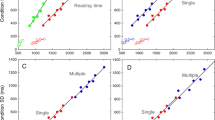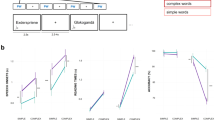Abstract
In a large subgroup of dyslexic individuals (D-LDs), reading difficulties are part of a broader learning and language disability. Recent studies indicate that D-LDs perform poorly in many psychoacoustic tasks compared with individuals with normal reading ability. We found that D-LDs perform as well as normal readers in speech perception in noise and in a difficult tone comparison task. However, their performance did not improve when these same tasks were performed with a smaller stimulus set. In contrast to normal readers, they did not benefit from stimulus-specific repetitions, suggesting that they have difficulties forming perceptual anchors. These findings are inconsistent with previously suggested static models of dyslexia. Instead, we propose that D-LDs' core deficit is a general difficulty in dynamically constructing stimulus-specific predictions, deriving from deficient stimulus-specific adaptation mechanisms. This hypothesis provides a direct link between D-LDs' high-level difficulties and mechanisms at the level of specific neuronal circuits.
This is a preview of subscription content, access via your institution
Access options
Subscribe to this journal
Receive 12 print issues and online access
$209.00 per year
only $17.42 per issue
Buy this article
- Purchase on Springer Link
- Instant access to full article PDF
Prices may be subject to local taxes which are calculated during checkout





Similar content being viewed by others
References
Demonet, J.F., Taylor, M.J. & Chaix, Y. Developmental dyslexia. Lancet 363, 1451–1460 (2004).
Shovmann, M.M. & Ahissar, M. Isolating the impact of visual perception on dyslexics' reading ability. Vision Res. 46, 3514–3525 (2006).
Ramus, F. Neurobiology of dyslexia: a reinterpretation of the data. Trends Neurosci. 27, 720–726 (2004).
Wright, B.A. & Zecker, S.G. Learning problems, delayed development, and puberty. Proc. Natl. Acad. Sci. USA 101, 9942–9946 (2004).
Tallal, P. Auditory temporal perception, phonics, and reading disabilities in children. Brain Lang. 9, 182–198 (1980).
Ahissar, M., Protopapas, A., Reid, M. & Merzenich, M.M. Auditory processing parallels reading abilities in adults. Proc. Natl. Acad. Sci. USA 97, 6832–6837 (2000).
Amitay, S., Ahissar, M. & Nelken, I. Auditory processing deficits in reading disabled adults. J. Assoc. Res. Otolaryngol. 3, 302–320 (2002).
Banai, K. & Ahissar, M. Poor frequency discrimination probes dyslexics with particularly impaired working memory. Audiol. Neurootol. 9, 328–340 (2004).
Goswami, U. et al. Amplitude envelope onsets and developmental dyslexia: a new hypothesis. Proc. Natl. Acad. Sci. USA 99, 10911–10916 (2002).
McAnally, K.I. & Stein, J.F. Auditory temporal coding in dyslexia. Proc. Biol. Sci. 263, 961–965 (1996).
Hari, R. & Renvall, H. Impaired processing of rapid stimulus sequences in dyslexia. Trends Cogn. Sci. 5, 525–532 (2001).
Mengler, E.D., Hogben, J.H., Michie, P. & Bishop, D.V. Poor frequency discrimination is related to oral language disorder in children: a psychoacoustic study. Dyslexia 11, 155–173 (2005).
Ben-Yehudah, G., Banai, K. & Ahissar, M. Patterns of deficit in auditory temporal processing among dyslexic adults. Neuroreport 15, 627–631 (2004).
France, S.J. et al. Auditory frequency discrimination in adult developmental dyslexics. Percept. Psychophys. 64, 169–179 (2002).
Heath, S.M., Hogben, J.H. & Clark, C.D. Auditory temporal processing in disabled readers with and without oral language delay. J. Child Psychol. Psychiatry 40, 637–647 (1999).
Wechsler, D. Wechsler Adult Intelligence Scale (WAIS-III) Administration and Scoring Manual (The Psychological Corporation, San Antonio, Texas, 1997).
Raz, N., Willerman, L. & Yama, M. On sense and senses: intelligence and auditory information processing. Pers. Individ. Dif. 8, 201–210 (1987).
Deary, I.J., Bell, P.J., Bell, A.J., Campbell, M.L. & Fazal, N.D. Sensory discrimination and intelligence: testing Spearman's other hypothesis. Am. J. Psychol. 117, 1–18 (2004).
Goswami, U. Why theories about developmental dyslexia require developmental designs. Trends Cogn. Sci. 7, 534–540 (2003).
Hulslander, J. et al. Sensory processing, reading, IQ, and attention. J. Exp. Child Psychol. 88, 274–295 (2004).
Banai, K. & Ahissar, M. Auditory processing deficits in dyslexia: task or stimulus related? Cereb. Cortex. 16, 1718–1728 (2006).
Romo, R. & Salinas, E. Flutter discrimination: neural codes, perception, memory and decision making. Nat. Rev. Neurosci. 4, 203–218 (2003).
Brosnan, M. et al. Executive functioning in adults and children with developmental dyslexia. Neuropsychologia 40, 2144–2155 (2002).
Helland, T. & Asbjornsen, A. Executive functions in dyslexia. Child Neuropsychol 6, 37–48 (2000).
Swanson, H.L. Working memory in learning disability subgroups. J. Exp. Child Psychol. 56, 87–114 (1993).
Sperling, A.J., Lu, Z.L., Manis, F.R. & Seidenberg, M.S. Deficits in perceptual noise exclusion in developmental dyslexia. Nat. Neurosci. 8, 862–863 (2005).
Hartley, D.E. & Moore, D.R. Auditory processing efficiency deficits in children with developmental language impairments. J. Acoust. Soc. Am. 112, 2962–2966 (2002).
McArthur, G.M. & Bishop, D.V.M. Frequency discrimination deficits in people with specific language impairment: reliability, validity, and linguistic correlates. J. Speech Lang. Hear. Res. 47, 527–541 (2004).
Halliday, L.F. & Bishop, D.V. Frequency discrimination and literacy skills in children with mild to moderate sensorineural hearing loss. J. Speech Lang. Hear. Res. 48, 1187–1203 (2005).
Harris, J. Discrimination of pitch: suggestions toward method and procedure. Am. J. Psychol. 61, 309–322 (1948).
König, E. Effect of time on pitch discrimination thresholds under several psychophysical procedures; Comparison with intensity discrimination thresholds. J. Acoust. Soc. Am. 29, 606 (1957).
Mori, S. & Ward, L.M. Intensity and frequency resolution: masking of absolute identification and fixed and roving discrimination. J. Acoust. Soc. Am. 91, 246–255 (1992).
Clement, S., Demany, L. & Semal, C. Memory for pitch versus memory for loudness. J. Acoust. Soc. Am. 106, 2805–2811 (1999).
Näätänen, R. Attention and Brain Function (L. Erlbaum, Hillsdale, New Jersey, 1992).
Baldeweg, T., Richardson, A., Watkins, S., Foale, C. & Gruzelier, J. Impaired auditory frequency discrimination in dyslexia detected with mismatch evoked potentials. Ann. Neurol. 45, 495–503 (1999).
Renvall, H. & Hari, R. Diminished auditory mismatch fields in dyslexic adults. Ann. Neurol. 53, 551–557 (2003).
Banai, K., Nicol, T., Zecker, S.G. & Kraus, N. Brainstem timing: implications for cortical processing and literacy. J. Neurosci. 25, 9850–9857 (2005).
Maurer, U., Bucker, K., Brem, S. & Brandeis, D. Altered responses to tone and phoneme mismatch in kindergarteners at familial dyslexia risk. Neuroreport, 14, 2245–2250 (2003).
Haenschel, C., Vernon, D.J., Dwivedi, P., Gruzelier, J.H. & Baldeweg, T. Event-related brain potential correlates of human auditory sensory memory-trace formation. J. Neurosci. 25, 10494–10501 (2005).
Kujala, T., Lovio, R., Lepistö, T., Laasonen, M. & Näätänen, R. Evaluation of multi-attribute auditory discrimination in dyslexia with the mismatch negativity. Clin. Neurophysiol. 117, 885–893 (2006).
Baldeweg, T. Repetition effects to sounds: evidence for predictive coding in the auditory system. Trends Cogn. Sci. 10, 93–94 (2006).
Grill-Spector, K., Henson, R. & Martin, A. Repetition and the brain: neural models of stimulus-specific effects. Trends Cogn. Sci. 10, 14–23 (2006).
Sperling, A.J., Lu, Z.L. & Manis, F.R. Slower implicit categorical learning in adult poor readers. Ann. Dyslexia 54, 281–303 (2004).
Ben-Yehudah, G., Sackett, E., Malchi-Ginzberg, L. & Ahissar, M. Impaired temporal contrast sensitivity in dyslexics is specific to retain-and-compare paradigms. Brain, 124, 1381–1395 (2001).
Ben-Yehudah, G. & Ahissar, M. Sequential spatial frequency discrimination is consistently impaired among adult dyslexics. Vision Res. 44, 1047–1063 (2004).
Ulanovsky, N., Las, L. & Nelken, I. Processing of low-probability sounds by cortical neurons. Nat. Neurosci. 6, 391–398 (2003).
Ulanovsky, N., Las, L., Farkas, D. & Nelken, I. Multiple time scales of adaptation in auditory cortex neurons. J. Neurosci. 24, 10440–10453 (2004).
Lyon, G.R. Toward a definition of dyslexia. Ann. Dyslexia 45, 3–27 (1995).
Putter-Katz, H., Banai, K. & Ahissar, M. Speech perception in noise among learning disabled teenagers. in Symposium on Plasticity of the Central Auditory System and Processing of Complex Acoustic Signals (eds. Syka, J. & Merzenich, M.M.) 251–257 (Springer, New York, 2005).
Dreschler, W.A., Verschuure, H., Ludvigsen, C. & Westermann, S. ICRA noises: artificial noise signals with speech-like spectral and temporal properties for hearing instrument assessment. International Collegium for Rehabilitative Audiology. Audiology 40, 148–157 (2001).
Acknowledgements
We thank M. Nahum, M. Shovman, A. Rokem and S. Greenberg for their help at various stages of this project. We thank S. Hochstein and E. Ahissar for comments on the manuscript. This study was supported by the Israel Science Foundation–Center of Excellence Grant, the Volkswagen Foundation and the Israeli Institute for Psychobiology.
Author information
Authors and Affiliations
Contributions
M.A. supervised the project and wrote the manuscript; Y.L. conducted Study II, statistical analyses and proofreading; H.P.-K. co-administered Study I and designed the nonadaptive speech perception test and K.B. designed, administered and analyzed the frequency discrimination tests.
Corresponding author
Ethics declarations
Competing interests
The authors declare no competing financial interests.
Rights and permissions
About this article
Cite this article
Ahissar, M., Lubin, Y., Putter-Katz, H. et al. Dyslexia and the failure to form a perceptual anchor. Nat Neurosci 9, 1558–1564 (2006). https://doi.org/10.1038/nn1800
Received:
Accepted:
Published:
Issue Date:
DOI: https://doi.org/10.1038/nn1800
This article is cited by
-
Repeated series learning revisited with a novel prediction on the reduced effect of item frequency in dyslexia
Scientific Reports (2022)
-
Perceptual bias reveals slow-updating in autism and fast-forgetting in dyslexia
Nature Neuroscience (2019)
-
Neuromodulation of maternal circuits by oxytocin
Cell and Tissue Research (2019)
-
Impaired neural mechanism for online novel word acquisition in dyslexic children
Scientific Reports (2018)
-
Reading ability and phoneme categorization
Scientific Reports (2018)



